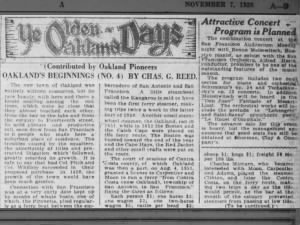 OAKLAND'S BEGINNINGS (NO. 4) BY CHAS. G. REED
Ye Olden Oakland Days
TO BLOG Sun, Nov 7, 1920 – Page 9 · Oakland Tribune (Oakland, California) · Newspapers.com
OAKLAND'S BEGINNINGS (NO. 4) BY CHAS. G. REED
Ye Olden Oakland Days
TO BLOG Sun, Nov 7, 1920 – Page 9 · Oakland Tribune (Oakland, California) · Newspapers.com
(Contributed by Oakland Pioneers OAKLAND'S BEGINNINGS (NO. 4) BY CHAS. G. REED.
The new town of Oakland was entirely without resources, but its rare beauty, with here and there a house nestling among the oak trees, which were so close that they almost touched each other, from the bay to the lake and from the estuary to Fourteenth street, its mild climate and productive soil, soon drew from San Francisco to it people who made here a suburban place of residence. The troubles caused by the squatters, the uncertainty of titles and protracted litigation which followed, greatly retarded its growth. It is safe to say that had Col. Fitch and Col. Whitney succeeded in their proposed purchase in 1850, the growth of the town would have been much greater.
Connection with San Francisco was at a very early date kept up by means of whale boats, one of which, the Pirouette, plied regularly as a ferry boat between the embarcadero of San Antonio and San Francisco. A little steamboat called the Kangaroo is said to have been the first ferry steamer, making trips twice a week in the latter part of 1850. Another small sternwheel steamer, the Oakland, ran in 1851, while in 1852 the Boston and the Caleb Cope were placed on the ferry route. The Boston was burned toward the end of the year and the Cape Hays, the Red Jacket and other small crafts were put on the route.
The court of sessions of Contra Costa county, of which Oakland was then a part, on Aug. 4. 1851, granted a license to Carpentier and Moon to run a ferry "from Contra Costa (now Oakland), township of San Antonio, to San Francisco," fixing the fares as follows:
Each person $1; one horse $3; one wagon $3; one two-horse wagon $5; cattle per head $3; sheep $1; hogs $1; freight 50 cts. per 100 lbs.
Charles Minturn, who became interested with Moon, Carpentier and Adams, placed the steamer Clinton, and later the Contra Costa, on the ferry route, making two trips a day as the tide would permit, as the bar at the mouth of the estuary prevented steamers from passing at low tide.
(To be continued.)

No comments:
Post a Comment